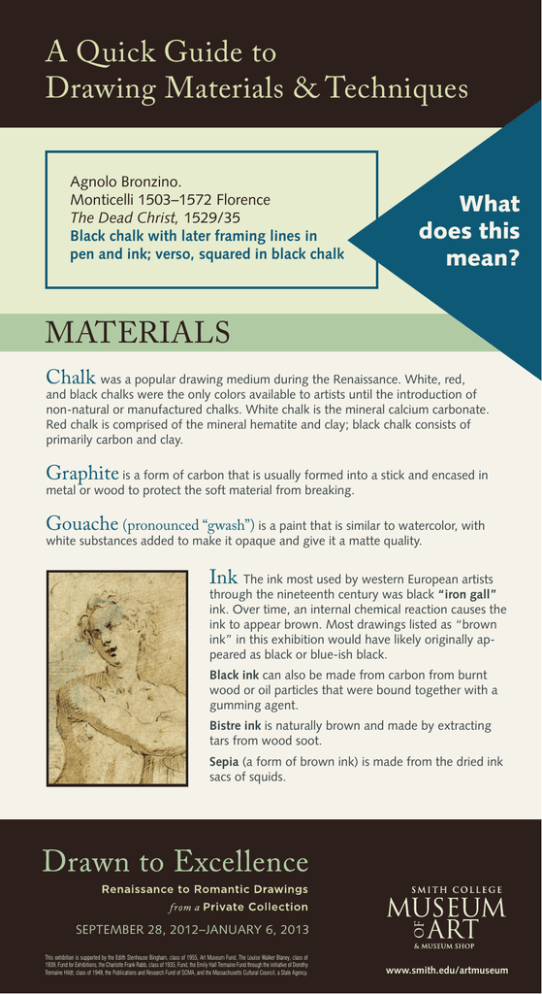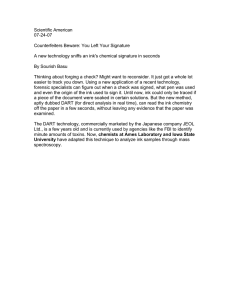A Quick Guide to Drawing Materials & Techniques MATERIALS What
advertisement

A Quick Guide to Drawing Materials & Techniques Agnolo Bronzino. Monticelli 1503–1572 Florence The Dead Christ, 1529/35 Black chalk with later framing lines in pen and ink; verso, squared in black chalk What does this mean? MATERIALS Chalk was a popular drawing medium during the Renaissance. White, red, and black chalks were the only colors available to artists until the introduction of non-natural or manufactured chalks. White chalk is the mineral calcium carbonate. Red chalk is comprised of the mineral hematite and clay; black chalk consists of primarily carbon and clay. Graphite is a form of carbon that is usually formed into a stick and encased in metal or wood to protect the soft material from breaking. Gouache (pronounced “gwash”) is a paint that is similar to watercolor, with white substances added to make it opaque and give it a matte quality. Ink The ink most used by western European artists through the nineteenth century was black “iron gall” ink. Over time, an internal chemical reaction causes the ink to appear brown. Most drawings listed as “brown ink” in this exhibition would have likely originally appeared as black or blue-ish black. Black ink can also be made from carbon from burnt wood or oil particles that were bound together with a gumming agent. Bistre ink is naturally brown and made by extracting tars from wood soot. Sepia (a form of brown ink) is made from the dried ink sacs of squids. SEPTEMBER 28, 2012–JANUARY 6, 2013 This exhibition is supported by the Edith Stenhouse Bingham, class of 1955, Art Museum Fund, The Louise Walker Blaney, class of 1939, Fund for Exhibitions, the Charlotte Frank Rabb, class of 1935, Fund, the Emily Hall Tremaine Fund through the initiative of Dorothy Tremaine Hildt, class of 1949, the Publications and Research Fund of SCMA, and the Massachusetts Cultural Council, a State Agency. www.smith.edu/artmuseum MATERIALS Paper was made from linen or hemp rags that were beaten into a pulp and mixed with water, until wood pulp was introduced at the end of the nineteenth century. Different qualities of rags produced varying shades of white to brown paper (the finer the fibers, the whiter the paper). A framed wire screen was dipped into the watery mixture so that a thin layer of pulp settled on top of the screen. Once dried, this layer formed one sheet of paper. The wire screens had varying types of patterns, which produced distinguishable effects on the finished paper. Colored papers such as blue or grey were created using previously dyed rags (the blue was from rags dyed with indigo). Prepared paper refers to the addition of a thinly applied colored substance (ex., gesso with pigment) onto plain paper. The paper color may change over time with light exposure. Pastels are made by combining ground pigments in a variety of colors with a non-greasy binder, which is then shaped into finger-length sticks. Pastels were first made in northern Italy around the sixteenth century and quickly gained popularity across Europe. Pens were made by sharpening the ends of bird feathers (quills) or reeds. The tips were dipped into ink and applied to the surface of the paper. Washes were made with diluted ink or watercolor applied with a brush. TECHNIQUES & OTHER TERMS Heightening Drawings could be heightened (or highlighted) with white in order to add to the dimensionality of forms. Heightening could be done with white chalk, a wet pigment applied with a brush, or by leaving areas of paper blank. Later Framing Lines Lines or decorative elements added by a later artist to frame the original drawing. Recto-Verso (“Front” and “Back,” respectively, of a double-sided drawing) Artists made efficient use of expensive paper by drawing on both sides. However, there is not usually one side that the artist meant to be the “front.” Squaring In order to transfer a design onto a larger surface such as a wall or canvas, the artist would draw grids containing equal numbers of squares on both the original drawing and the new surface. The design was then transferred square by square. Stumping Stumps made from rolls of leather or paper were used to blend chalk, pastel, or graphite to create a softer appearance on the drawing. Images FRONT: Girolamo Francesco Maria Mazzola, called Il Parmigianino. Parma 1503–1540 Casalmaggiore. Nude Man Standing beside a Pedestal (detail), 1530/40. Pen and brown ink with brown wash over traces of black chalk. Private Collection. Photograph by Ricardo Blanc. Courtesy National Gallery of Art, Washington, D.C. ABOVE TOP: Francesco Londonio. Milan 1723–1783 Milan. Young Shepherd Boy Leaning on a Staff (detail), 1760/65. Black chalk heightened with white on buff-colored paper. Private Collection. Photograph by Petegorsky/Gipe. ABOVE BOTTOM: Santi di Tito. Borgo San Sepulcro 1536–1603 Florence. The Adoration of the Shepherds (verso, detail), 1580s. Pen and brown ink with brown wash over black chalk and stylus indications, squared in brown ink. Private Collection. C Printed digitally on recycled paper with 50% hydroelectric power.



